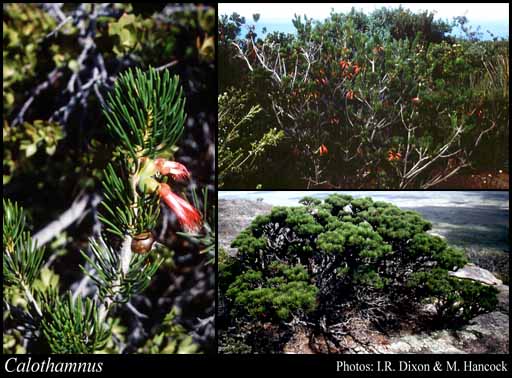- Reference
- Nov.Holl.Pl. 2:25, Tab. 164 (1806)
- Name Status
- Current

Scientific Description
Common name. One-sided Bottlebrushes. Family Myrtaceae.
Habit and leaf form. Trees, or shrubs (rarely with tuberous roots: C. tuberosus); evergreen; bearing essential oils. Plants with neither basal nor terminal concentrations of leaves; to 0.5–4 m high. Leptocaul. Helophytic to xerophytic. Leaves small to very large; whorled, or alternate to opposite (? scattered or densely crowded at end of branches); ‘herbaceous’, or leathery; sessile; gland-dotted (though glands sometimes not prominent); aromatic; edgewise to the stem, or with ‘normal’ orientation; simple; epulvinate. Leaf blades dorsiventral, or isobilateral, or centric; entire; flat, or solid; terete; linear, or lanceolate, or oblong, or ovate; linear, or obovate; pinnately veined, or parallel-veined, or one-veined; cross-venulate, or without cross-venules. Mature leaf blades adaxially glabrous, or scabrous, or pilose, or pubescent; abaxially glabrous, or scabrous, or pilose, or pubescent. Leaves without stipules; without a persistent basal meristem. Leaf anatomy. Hairs present, or absent. Stem anatomy. Secondary thickening developing from a conventional cambial ring.
Reproductive type, pollination. Fertile flowers hermaphrodite. Unisexual flowers absent. Plants hermaphrodite. Pollination mechanism unspecialized.
Inflorescence and flower features. Flowers solitary (rarely), or aggregated in ‘inflorescences’ (usually). Inflorescence few-flowered, or many-flowered. Flowers in spikes. Inflorescences simple, or compound. The terminal inflorescence unit cymose. Inflorescences never terminal; unilateral or cylindrical, or flowers clustered; with involucral bracts, or without involucral bracts; pseudanthial. Flowers sessile; ebracteate; bracteolate, or ebracteolate; small to medium-sized; regular, or somewhat irregular. The floral asymmetry involving the perianth, or involving the androecium. Flowers 4 merous, or 5 merous; cyclic. Free hypanthium present (petals ‘inserted on the calyx’); campanulate to tubular; glabrous or pubescent, often immersed in the stems. Perianth with distinct calyx and corolla; 8, or 10; 2 -whorled; isomerous. Calyx present; 4, or 5; 1 -whorled; polysepalous, or gamosepalous (depending on interpretation); lobed; erect, or spreading; imbricate, or valvate; regular, or unequal but not bilabiate (in some 4-merous species); persistent (may be reduced to (1-)2 segments), or not persistent. Sepals triangular. Calyx lobes triangular. Corolla present; 4, or 5; 1 -whorled; polypetalous; imbricate; regular; glabrous abaxially (usually), or hairy abaxially (in C. aridus); glabrous adaxially (usually), or hairy adaxially (in C. aridus); plain; pink, or orange to brown, or green to yellow; persistent, or deciduous. Petals elliptic, or oblong, or ovate, or obovate; clawed, or sessile. Androecial members definite in number, or indefinite in number (usually). Androecium 8–150. Androecial members branched, or unbranched. Androecial sequence determinable, or not determinable. Androecial members maturing centripetally; free of the perianth; all equal (usually), or markedly unequal (the upper groups broad, the lower reduced in size and with reduced numbers of filaments); coherent (bundled into staminal claws); 5 - adelphous, or 4 - adelphous, or 3 - adelphous (when upper two claws are fused in C. sanguineus). The androecial groups opposite the petals. Androecium exclusively of fertile stamens (usually), or including staminodes (the two lower claws sometimes sterile, or there may be sterile anthers mixed with fertile ones). Stamens 8–150; attached on the rim of the hypanthium; becoming exserted (exceeding the petals); diplostemonous to triplostemonous, or polystemonous (usually); alternisepalous; all opposite the corolla members; erect in bud, or inflexed in bud. Filaments not geniculate; hairy, or glabrous. Anthers basifixed; non-versatile; dehiscing via longitudinal slits (ventral); introrse; bilocular (cells elongate, parallel); tetrasporangiate; appendaged, or unappendaged. Gynoecium 3 carpelled. The pistil 3 celled. Gynoecium syncarpous; eu-syncarpous; inferior. Ovary plurilocular; 3 locular. Ovary summit hairy, the hairs not confined to radiating bands. Epigynous disk present. Gynoecium stylate. Styles 1; simple; apical; persistent, or deciduous; hairless. Stigmas 1. Placentation axile. Ovulodes present (numerous). Ovules c. 40 per locule; ascending; non-arillate; anatropous.
Fruit and seed features. Fruit sessile; persistent (usually), or falling from the plant before the next growing season (in C. sanguineus); non-fleshy; hairy, or not hairy; not spinose; dehiscent; a capsule. Capsules septicidal, or loculicidal, or denticidal, or circumscissile. Fruit few seeded. Seeds non-endospermic; minute to small; conspicuously hairy (ciliate on angles), or not conspicuously hairy; winged, or wingless. Cotyledons 2.
Geography, cytology, number of species. Native of Australia. Endemic to Australia. Australian states and territories: Western Australia. South-West Botanical Province.
Etymology. From the Greek for "beautiful" and "bush, shrub".